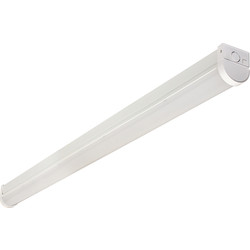The 58 watt tube is meant to work with the same ballast as the 65 watt. Indeed the later ballasts were labelled as suitable for both. I suggest you were unlucky and a sample of one is meaningless.
When the 65 watt tube was used the UK voltage was 240 volt, when we went to 230 volt in real terms nothing happened, but when we started to use solar panels, over volt would cause them to lock out, so as solar panels arrived so the voltage in real terms dropped.
It was at this point when 58 watt tubes failed to run for any time in 65 watt fittings, it was likely a combination of volt drop and change of tube type, the 58 watt tube would work for a short time, but where the 65 watt version had a typical life of 6 years, the 58 watt version was more like 6 months, I am sure if the ballast was changed then it would have worked.
The LED tube lasted 18 months, and at that time house was mainly empty, the replacement lasted until my son swapped to GU10 down lights, so that could have been one odd tube failure.
I have not had many LED lights fail, lost a few GU10, but in the main they were smart bulbs, so could well be something to do with the smart circuit. I do have SPD fitted, my son doesn't and he has lost quite a few GU10's how much is due to spikes I don't know, however since 95% of the LED failures have been GU10's one tends to think it is something to do with the package, maybe too small to dissipate the heat?
The odd 4 low voltage MR16 lamps, from a toroidal transformer have lasted over 10 years, but the fluorescent lamp on landing in old house was fitted in 1995 and used a lot, and on its second tube, and first one was second hand, since it is an emergency lamp, it has an electronic ballast, only one lamp, but seems to show the claims that tubes last longer with electronic ballasts is true.
The problem is the tube is rated for use with magnetic ballasts, but it is claimed electronic ballasts use less power, produce more light, and extend the life of the tube, so in real terms a 5 foot fluorescent is the same as a 5 foot LED, the only question is mercury or the nasties found in LED's, since the LED tube is made of plastic it is less likely to release the nasties which are worse than the fluorescent nasties, but it depends on how the waste is dealt with.
Most my waste is collected by the council, there are places to put batteries and light bulbs tubes etc. If I travel 16 miles to the collection site, but how many will do that, battery, light bulbs, tubes etc, end up in general rubbish. The outlets who sell them, should also deal with failed returns, I tried it with Wicks when I got my last 65 watt tube, and they would not take it, so never tried again.


